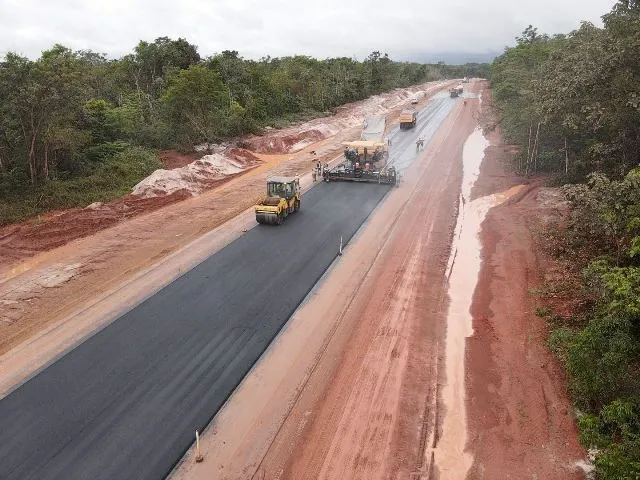The Ministry of Public Works notes recent international media reporting concerning the Linden–Mabura Road Project. While open discourse on public investments is welcomed, it is essential that such discussions reflect the facts, historical context, and developmental purpose of this landmark initiative. The article in question presents an incomplete and, in several respects, inaccurate portrayal of the project’s origins, objectives, and governance. The Ministry therefore provides the following clarification on behalf of the Government of the Co-operative Republic of Guyana.
2. Historical Context and Strategic National Purpose
The Linden–Mabura Road Project is not a new or arbitrary undertaking. The corridor was first defined in the 1920s under colonial administration and subsequently advanced through the Georgetown–Linden (McKenzie) Lethem Project of the 1960s, which enjoyed support from the United States. The current works resume and modernise that long-standing effort, continuing a historic national development vision almost a century in the making
Completion of this phase of the project will enable Guyana to exercise full overland access across its sovereign territory west of the Essequibo River an objective of longstanding national importance. It strengthens the nation’s ability to connect coastal and hinterland regions, facilitate trade, and promote balanced national growth. The Linden–Mabura corridor is thus central to Guyana’s territorial cohesion and its economic integration strategy.
3. Economic Integration and Regional Development
The project represents a cornerstone of Guyana’s regional connectivity. By linking Guyana’s coastal economy to Brazil’s northern states, the road will substantially enhance bilateral trade, promote logistics efficiency, and stimulate mutual economic growth. The improved corridor will create new opportunities for cross-border commerce, strengthen supply chains, and enable cost-effective movement of goods between South America and the Atlantic seaboard.
These developments promise tangible benefits for both countries particularly for communities in Brazil’s State of Pará and neighbouring regions as well as for Guyanese hinterland populations that have historically been constrained by limited transport access. The initiative is therefore a win-win development partnership, advancing regional cooperation and unlocking new trade and investment potential.
4. Alignment with International Climate Finance Objectives
The financing provided under the UK Caribbean Infrastructure Fund (UKCIF), administered by the Caribbean Development Bank (CDB), is entirely consistent with the principles of climate-resilient development. Climate finance extends beyond renewable energy; it also supports infrastructure that mitigates the effects of climate change and strengthens national resilience.
The Linden–Mabura Road Project fulfils these objectives by ensuring reliable year-round access during the rainy season, reducing vehicle emissions through improved efficiency, and safeguarding essential connectivity in flood-prone regions. The project was independently appraised and approved in accordance with the CDB’s environmental, social, and fiduciary standards, ensuring full compliance with international best practice.
5. Environmental Stewardship and Sustainable Development
The project upgrades an existing transport route, it does not carve a new path through untouched rainforest. Extensive Environmental and Social Impact Assessments were undertaken before implementation, and strict mitigation and monitoring measures are in place. Guyana remains a global leader in sustainable forest management, with over 85 per cent of its forest cover intact, and continues to pursue a low-carbon development path under its Low Carbon Development Strategy 2030.
Environmental preservation and development are not mutually exclusive. The Government continues to ensure that infrastructure works are implemented responsibly, respecting biodiversity, traditional knowledge, and the livelihoods of Indigenous and local communities.
6. Social and Community Benefits
The project will deliver wide-ranging socio-economic benefits. It will reduce transportation costs for citizens and visitors alike, support tourism especially community-based and eco-tourism ventures—and create sustainable jobs and business opportunities. For hinterland and Indigenous communities, the improved corridor will expand access to healthcare, education, emergency services, and markets, promoting inclusion and empowerment.
7. Governance, Transparency, and Accountability
All procurement and implementation processes have been conducted under the oversight of the Caribbean Development Bank and in compliance with the Government of Guyana’s financial regulations. The project is subject to independent auditing, public disclosure requirements, and continuous monitoring. Any insinuation of impropriety or waste is entirely unfounded. The Ministry reaffirms its commitment to transparency, accountability, and value for money in every aspect of public works execution.
8. Conclusion
The Linden–Mabura Road Project stands as a defining national achievement—one that advances integration, climate resilience, and regional partnership. It exemplifies Guyana’s commitment to responsible, transparent, and sustainable development for the benefit of all its people.
The Government of the Co-operative Republic of Guyana values its enduring partnership with the United Kingdom and international development institutions. Constructive collaboration between nations must, however, be grounded in fairness and fact. The Ministry therefore encourages continued engagement based on accurate information and mutual respect as Guyana builds a modern, resilient, and inclusive future.





